|
Website: http://www.truevalue.com
Level of difficulty: All LevelsTools And Materials:
- Philips screwdriver
- Grout saw
- Vacuum
- Plain (not sanded) grout
- Mixing container
- Paint stick or other stirrer
- Plastic straw
|
- Rubber float
- Large man-made sponge
- Cheesecloth
- Mildew-resistant "tub 'n tile"
- Caulk
- Caulking gun
- Silicone grout sealer
|
 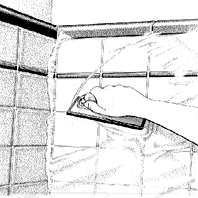
If you're like most people, you've already put off the job too long. The best time to deal with this problem is as soon as you see cracks that indicate
the wall grout has failed. This step-by-step project assumes you need to regrout the entire wall area. More often, the need to regrout is limited to the
damaged areas. If you are only making minor repairs, you can skip the first three steps. If the failure occurs at the tub-tile joint, that's no surprise.
That joint should be caulked.
Caulk remains flexible and allows for the inevitable movement of the tub as its filled with hundred of pounds of water and people. Grout is not waterproof.
Therefore, you should wait a minimum of 48 hours until the grout has fully cured and then apply a silicone grout sealer according to directions on the label.
An old toothbrush works well to apply it.
Grout sealer, spilled on the tub floor, is very slippery! Use caution in applying it, and wipe up spills with a soapy detergent.
Before You Begin:
Plan not to use the shower (or tub) for at least three days. Grout and caulk need 48 hours to cure before you can apply a grout sealant, which takes
at least another full day. When you're ready to work, place tape over the drain to keep out debris. Place a canvas drop cloth over the floor of the tub
or shower to protect the surface from the sand-like grout that can scratch it. Just before you're ready to grout, mix an appropriate amount by adding water
slowly to the powder until the right consistency is reached. Grout should be just stiff enough so it won't pour out of a container. Then let it rest for
about 10 minutes.
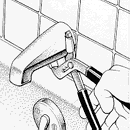 1. Remove Tub Spout
1. Remove Tub Spout
If the tub spout screws off, twist it either by hand or with groove-joint pliers padded with tape to prevent marring the spout finish. If you have
the type that slips over a copper nipple, use a hex key (also called Allen wrench) to loosen the setscrew on the underside to twist-pull the spout
off. |
 Tip:
Tip:
Spout stuck? Try inserting the blade of a large screwdriver or the handle of a pair of pliers into the spout opening to twist |
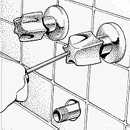 2. Remove Hardware
2. Remove Hardware
To remove faucet handles, first use a nail file or knife to pop off any decorative cap that covers the handle screw. Then, remove the screw with
a Philips head screwdriver and pull the handle straight out. |
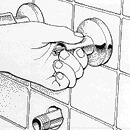 3. Remove Trim
3. Remove Trim
With the handles off you can remove the trim by hand. First, unscrew the stem nipple (a cylindrical sleeve) from the valve and either unscrew or
pull off the escutcheon (the flange that hides the rough hole in the tile). To free the escutcheon, you may need to score any caulk between it and
the tile with a utility knife. |
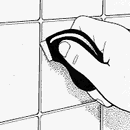 4. Extract Grout
4. Extract Grout
Use an abrasive grout saw to remove as much grout from the joint as you can. Some grout saws have teeth, others have abrasive coatings on the blade.
Use either type with care to avoid scratching the tile. This can be a time-consuming task. |
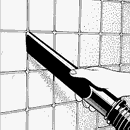 5. Vacuum Debris
5. Vacuum Debris
Use the wand attachment on a vacuum to remove all dust. Clean the grout to remove all mildew using bleach or a commercial mildew remover. Rinse
well and allow it to dry until there is no standing water in the joints. (If you vacuum has a blower port, use the air pressure to blow out any
water.) |
 Tip:
Tip:
If the wall is bone dry, lightly mist the scraped out joints with water, before moving to the next step. |
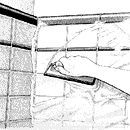 6. Apply Grout
6. Apply Grout
Apply grout with a rubber float (grout trowel). Hold the float at a 45-degree and spread the grout diagonally across the tile. Press the grout into
all joints to fill all voids, and go over the entire area 2-3 times. (For a limited area, you can use your fingertip or a rubber spatula to apply
the grout.) When joints are filled, hold the tool at nearly a 90-degree angle and cut off excess. |
 Tip:
Tip:
If you're new to the task, mix and apply the grout in two or three batches so it won't get too stiff before you have time to work with it. |
 5. Vacuum Debris
5. Vacuum Debris
Use the wand attachment on a vacuum to remove all dust. Clean the grout to remove all mildew using bleach or a commercial mildew remover. Rinse
well and allow it to dry until there is no standing water in the joints. (If you vacuum has a blower port, use the air pressure to blow out any
water.) |
 Tip:
Tip:
If the wall is bone dry, lightly mist the scraped out joints with water, before moving to the next step. |
 6. Apply Grout
6. Apply Grout
Apply grout with a rubber float (grout trowel). Hold the float at a 45-degree and spread the grout diagonally across the tile. Press the grout into
all joints to fill all voids, and go over the entire area 2-3 times. (For a limited area, you can use your fingertip or a rubber spatula to apply
the grout.) When joints are filled, hold the tool at nearly a 90-degree angle and cut off excess. |
 Tip:
Tip:
If you're new to the task, mix and apply the grout in two or three batches so it won't get too stiff before you have time to work with it. |
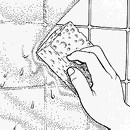 7. Allow Grout to Set
7. Allow Grout to Set
You need to allow the grout to set so it won't be wiped out of the joint as you clean the tile before the grout dries. Test for readiness within
a few minutes by wiping down a small area using a damp sponge. Wipe off all excess grout leaving a light haze. Wipe the tile diagonally. Rinse and
wring-out the sponge often. |
 Caution: Do NOT allow grout to cure on the surface of the tile. If left too long, only acid will remove it (and ruin your grout job in the process).
Caution: Do NOT allow grout to cure on the surface of the tile. If left too long, only acid will remove it (and ruin your grout job in the process).
|
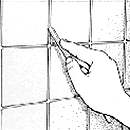 8. Shape Joints
8. Shape Joints
Next, you need to clean and shape the joints. This time use the slightly damp sponge to lightly wipe parallel to the joints to remove any excess
grout and until the level is just below the rounded edges of the tile. Fill any voids that appear using a fingerful of grout. Smooth the grout with
a plastic straw. |
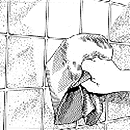 9. Wipe Clean
9. Wipe Clean
After the grout has cured another 10-15 minutes, wipe off the grout haze with cheesecloth (or a soft, dry cotton cloth). If the haze has bonded,
use a green abrasive pad. In the worst case, you may need to use a grout haze cleaning solution available from your professional tile dealer.
|
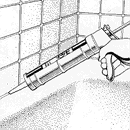 10. Caulk Tub
10. Caulk Tub
In the tub-tile joint, dig out damaged grout. Grout does not bond well with porcelain and cracks with movement. Overfill the joint with caulk. Next,
draw a wet finger over the caulk to smooth and level it to the same depth of the grouted joints or use a small plastic tool designed specifically
for this purpose. |
Note: This article was submitted by a second party and the contents are subject to our disclaimer.
|

